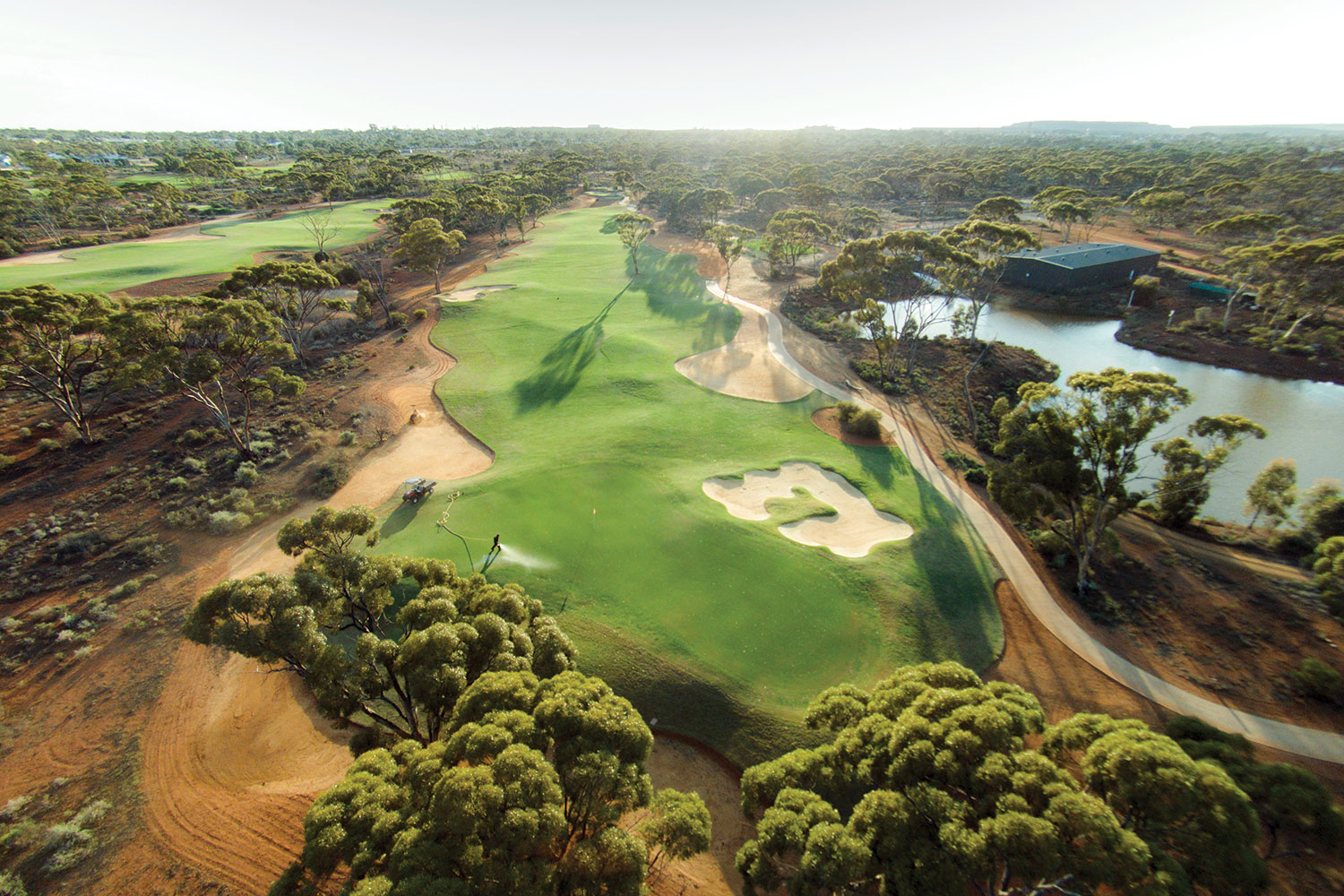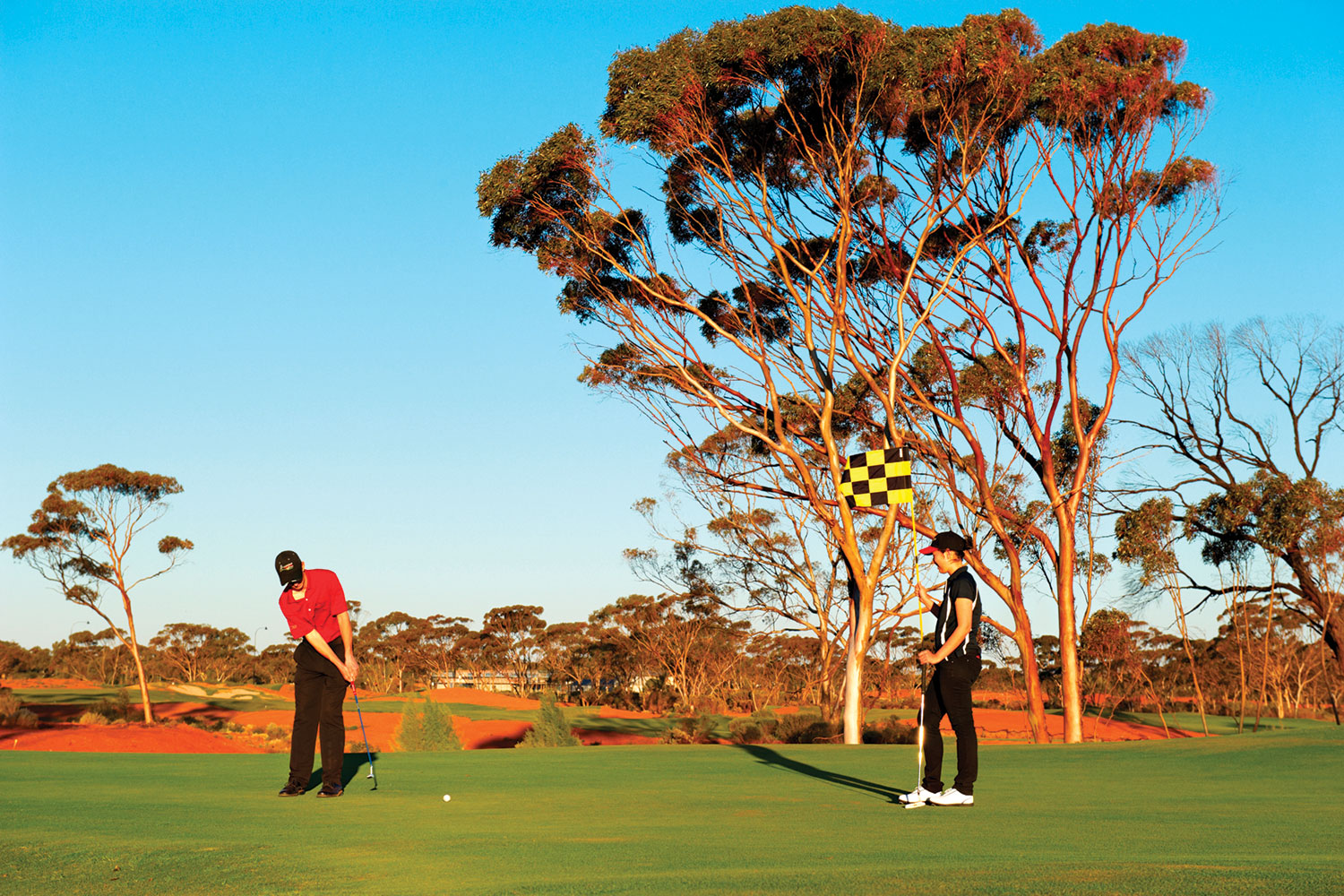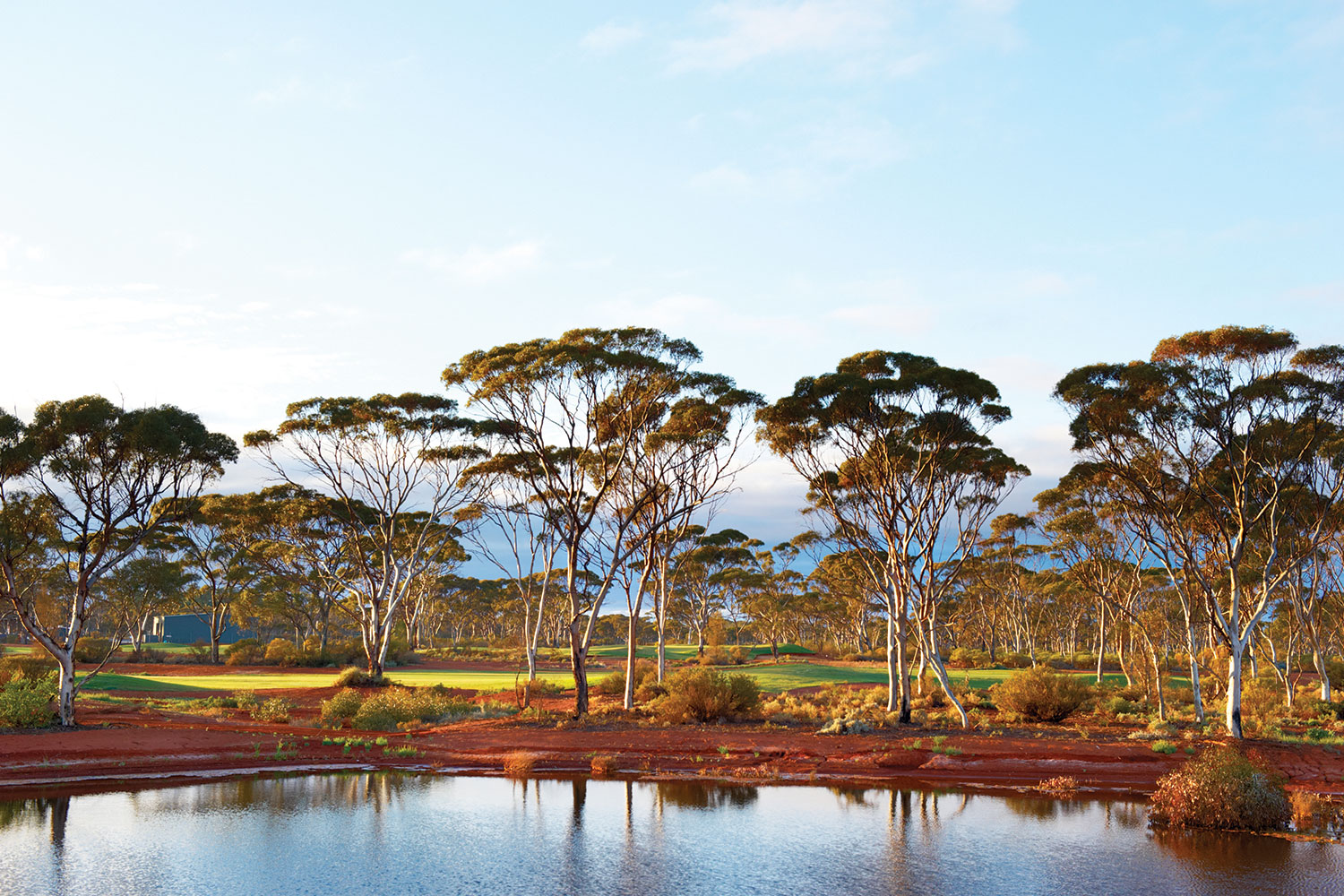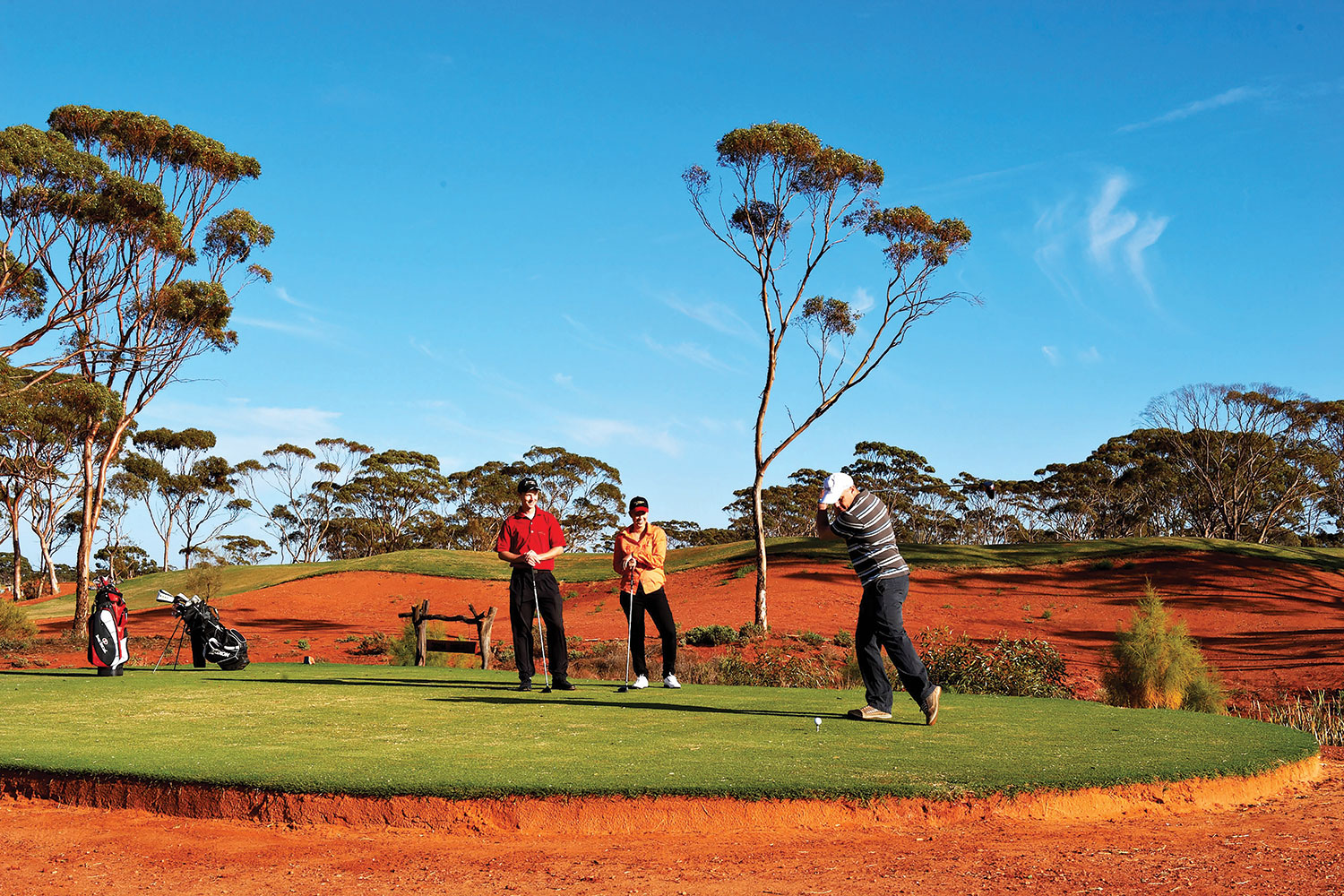ON JANUARY 14, 1944, I was born to Barbara and Ken Marsh in a hospital in Kalgoorlie. As one would expect, I had little idea at the time that a golf club had been born in this ‘wild west’ town 54 years prior to my first day on planet earth.
History reminds us that Kalgoorlie Golf Club, which was laid down in 1899 on the old racecourse, is considered the second oldest golf club in Western Australia. One can only speculate what playing conditions the golfers of this time would have endured in pursuit of their favourite pastime.
I spent precious little time in Kalgoorlie, as my parents moved closer to Perth weeks after I was born. Kalgoorlie was a city of folklore proportions for all those living on the coast of WA. It was, after all, the most travelled gateway by road and train across the legendary Nullarbor Plain to the eastern states. It was a town probably more famous for countless bars, prolific gambling and unspoken activities that were legendary throughout the entire nation.

I was lucky enough to make several fleeting visits during the ensuing 56 years, however my interest in Kalgoorlie spiked to an entirely new level when I was approached to design a desert-style golf course in the city that then held the title of the gold mining capital of Australia.
The proposal was fairly straightforward. The three golf clubs in the area, Hannans, Kalgoorlie and Boulder, would amalgamate and be relocated to a site north-west of the city that encompassed the old tip site that had been used by the city for years. Finance was to be provided via a private developer with total overseeing support from the state and local government.
My company, Graham Marsh Golf Design, was appointed as the golf architect and received a brief that clearly enunciated what the city was hoping to achieve. Those of us who have spent time in the golf industry understand and realise that while it is always a worthy goal to aim high, sometimes the reality of lofty goals can be encumbered by unforeseen circumstances and financial limitations.
The comprehensive proposal called for 36 holes of golf and a five-star resort with all the trimmings that are typically demanded by tourists who venture to destination golf resorts.

Despite best intentions, a few months into the project the alarm bells started to ring. The finance was not as secure as first imagined and the project was scaled back in principal to 18 holes and a temporary clubhouse. For the council and those who backed the project at the highest level, this was a harrowing experience. Painfully for two years, the City of Kalgoorlie-Boulder suffered in agony as its dream of building an international tourist facility in their city teetered on the brink of disaster.
To its eternal credit, the city faced disaster straight on and forged ahead with a plan to fulfill its obligation to the place it so proudly called home. Only those close to the project and within the inner circle of the administration will truly understand how many times they faced the impossible and how they struggled undeterred with laser-like determination to give the local golfers, tourists and the residents the first-class facility they had promised.
I distinctly recall my first design visit. As I roamed the site my mind was racing; this was my opportunity to design Australia’s first genuine desert golf course.
Fortunately, I had become very familiar with desert golf, as I had played in a number of tournaments in Arizona, Nevada and California. My victory at the Senior Tour’s Players Championship came on one of Jack Nicklaus’ six courses at Desert Mountain in Scottsdale, Arizona.

I have always found desert golf an exhilarating experience. In many ways it is at odds with a number of core principals of my design philosophy. Most desert courses are driven by availability of water, and the grass footprint of the majority of desert golf courses is well below the standard fairway areas one is likely to find on a parkland or resort course. Personally, I have always preferred a welcome entrance to most of my green sites so the golfer can bounce or run his ball up onto the green surface. I have long believed this affords many of those with higher handicaps a much more pleasurable golf experience.
Forced carries from tees to fairways and from fairways to green complexes almost become mandatory design tools in the endeavour to conserve the single biggest asset a golf course in a desert location possesses: water. Managing the balance between desert and grass becomes a fine line as, if taken too far, penal golf becomes the norm and can frustrate all but those who possess the highest skills of the game.
Fortunately the council provided the project with a water source that was more than adequate, allowing us to design a course that kept the number of forced carries to a manageable level.
The majority of the site was flat and largely consisted of red soil highlighted by the distinctive brilliant pink trunks of the native salmon gums. The undergrowth was a mixture of grey/green spindly saltbush interspersed with a variety of season desert flowers. I found it strikingly rugged yet at the same time enchantingly beautiful as it changed character throughout the course of the day, predominantly against a backdrop of a crystal clear blue sky.
The old tip site of approximately 30 hectares was a blessing in disguise as it afforded a number of the holes a modicum of elevation change. The dramatic and exciting triple-tiered ninth green takes full advantage of this, as does the long, dogleg-left, 550-metre, par-5 15th. The tee shot at the 15th is to a plateau that hangs off the side of the tip. From this vantage point the remainder of the hole is speckled with a series of bunkers all positioned to encourage the golfer to choose their preferred line of attack. Maybe this hole, named “Golden Mile”, would be more aptly named “Devil’s Elbow” as it has the uncanny ability to remove anything golden from your scorecard during an aspiring round.

Hole 17, the “Super Pit”, is the hole that has drawn the most attention and respect. This slightly downhill par 3 of some 202 metres from the championship plate has something for all. It appears to hover in space only supported by the old tip on the left side of the green. The cavernous drop on the right to the desert floor attracts balls like a honey pot would bees. Even on the calmest of days it is a daunting shot and when the wind sweeps across the desert plains, as it so often does, it becomes the most feared tee shot on the entire course. It is a stunningly beautiful moment late in the day to experience the sunlight shimmering on the canopy of the salmon gums that form the backdrop of this dramatic green site.
It would be grossly unfair to the remaining holes, which wind their way through the flatland and dry creek beds, to suggest that the previously aforementioned holes were the best on offer.
Holes five, six, seven and the par-3 eighth all provide strategic challenges that include angled dry creek beds, wastelands and a series of green complexes to test the elite and inspire the average player to manage their game.
The diversity of the inward nine comprehensively showcases the multitude of shot options the course has to offer. The exciting par-5 11th, reachable in two shots on some days, the driveable par-4 12th, for those with strong shoulders and an adventurous style of play, and the short par-3 13th, which demands deft accuracy and distance control, are all memorable holes. Collectively they are for the taking and can set up an opportunity for a string
of birdies prior to the challenging trek back to the barn.
Justifiably so, the brief called for a true championship course that would test the best the game had to offer. It also clearly enunciated that the course must be playable for the average member. Multiple tees on all holes ensures the carries over the red soil are palatable and much thought was given to the angling of the green complexes that were abutted by either the mandatory drainage creeks or the open desert that was strategically introduced as a means of saving precious water, otherwise known as liquid gold in the outback.
Since its official opening in November 2010, the course has been tested by a number of PGA events and its reputation has proudly survived with distinction. As predicted, the members have surely been tested as playing this new course is a format of golf most never knew existed.
The Goldfields Golf Course is a stark reminder of how far golf in the goldfields has progressed since 1899 when the first nine-hole layout in Kalgoorlie was opened on the old racetrack. Thanks to the City of Kalgoorlie-Boulder and the WA Government, golf in Kalgoorlie has proudly stamped its claim on the international golf scene.
Recently, there was an agreement signed with the city to finally build the accommodation that was such an integral part of the initial development proposal. For golfers throughout Australia, this is incredibly exciting news as it will finally bring the city closer towards achieving the vision it so clearly laid out at the turn of the century.
With the inevitable closing of the iconic “Super Pit” in the foreseeable future, a landmark that has so much defined the city’s history, just maybe the Kalgoorlie-Boulder Golf Course will be the little nugget of gold that will transcend time and prevail long after the last veins of gold-bearing ore have been extracted and processed.
Why not? After all, this grand old game has been around for longer than 500 years.
THE DETAILS
Kalgoorlie Golf Course
93 Aslett Drive, Karlkula WA 6430
(08) 9026 2626
kalgoorliegolfcourse.com




